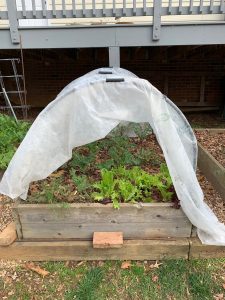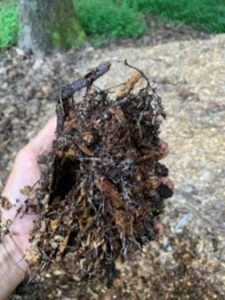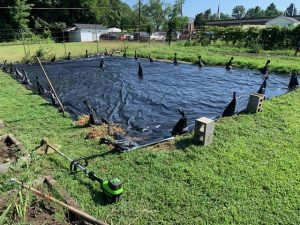October signals the beginning of the end of our outdoor vegetable and fruit growing season. It’s the last chance to plant a few short-cycle vegetables, harvest temperature sensitive produce before our first frost, document the gardening year, clean up the beds, and prepare beds for winter. Let’s dig into the possibilities.
Planting and Harvesting
If you planted crops for fall harvest in August or September, you may already be harvesting fast-maturing plants like some lettuces and radishes. According to the VCE Home Garden Vegetable Planting Guide, those of us in Hardiness Zone 7b are still able to plant baby lettuces, radishes, mustard, and spinach during the first part of October. With an average first frost date of October 25th-November 5th, late planters have the possibility of another crop before winter.
October is the best time to plant garlic. Planting early to mid-month to give the cloves 3 or 4 weeks to take root, but not enough time to sprout above ground before frost, is the goal. Good guidance is available in the article Growing Garlic: Fall Planting from the Penn State Extension.
Watch the two-week weather forecast and plan to protect any sensitive crops ahead of predicted frosts to maximize your harvest.
Frost preparation:
To get a better understanding of frost damage and vegetables that are susceptible to light, medium and hard frost exposure, refer to the article Identifying and Preventing Freeze Damage in Vegetables from the Michigan State University Extension.
To nurse plants further into the fall and winter, there are several options:
- Wet your soil: there is some evidence that watering ahead of a frost will keep the air temperature above the soil as much as 5 degrees warmer than dry soil and will maintain the differential overnight.

- Cover your plants: For better protection, cover the crops that aren’t cold hardy. Spun polyester row cover fabric is a proven choice, although gardeners use everything from newspapers to buckets to commercially available water-jacketed individual plant covers. Fabric cover protection varies from 2 to 6 degrees Fahrenheit depending on soil conditions and fabric used. Air space between cover and plants increases the protection over that obtained by simply laying the cover directly on the vegetation. Spun fabric covers let light and water through and can be left in place. Most other options need to be removed during the day after the temperature is above freezing. For more information on row covers please check out the article: Row Covers from the University of Maryland Extension.

- Cold Frames: Cold frames provide a more permanent way to combat both spring and fall frosts. Tips on construction and on using cold frames are available in the Colorado State Extension article Extending the Season with Cold Frames.

- After frost, cut back asparagus foliage to within 2 inches of the ground.
- If you haven’t done a soil test in a few years, fall is a good time to get one. Organic amendments added in the fall will be ready for plant uptake in the spring. In the Charlottesville/Albemarle area, test kits and instructions are available at the Extension Office in the County Building off the 5thSt Extension.

- There is still time to plant a cover crop. Cover crops protect the soil over the winter, store unused nutrients to prevent leaching, and provide organic matter in the spring when tilled under or composted. It is late to plant a mixed crop but Winter Rye is a possible late season solution that adds organic matter and helps break up compacted soil. More information is available from the article Cover Crops from the University of Maryland Extension.

- If you aren’t planting a cover crop, protect the garden soil with a few inches of mulched leaves, aged wood chips, or straw. Mulch reduces nutrient leaching and carbon loss while moderating temperature variation and adding organic matter.
- If you have a garden section that has struggled with weed, insect or disease issues and you feel the need to take strong action before planting next spring, consider occultation or solarization. Covering the area or areas with a silage tarp, black for occultation or clear for solarization, can help. String trim weeds and cover the area this fall, leaving the tarp in place until spring planting. When the tarp is removed, the issues should be significantly reduced.

- The photo above shows a silage tarp on a section of garden in one of the Cultivate Charlottesville gardens. Our plan is to remove it in the spring and report on how successful it is at reducing the rhizome driven spread of Bermuda grass throughout the garden. More info is available in the article Using the Sun to Kill Weeds and Prepare Garden Plots from the U of Minnesota Extension.
- If you haven’t kept up with garden documentation this year, this is your last chance. It’s a good idea to diagram the garden along with what was planted in each section including spring, summer and fall crops.
- If you have struggled with disease this year, crop rotation can be an effective way to reduce the problem next year. For it to be most effective, gardeners should not plant vegetables belonging to the same family in the same location for at least three years. Crop rotation in a small garden may be difficult. However, we should rotate our vegetable crops to the extent possible. Crop rotation is an important organic tool for minimizing passing insect and disease problems from one season to the next. You can find an informative listing of plant families in the Penn State Extension article Plant Rotation in the Garden Based on Plant Families.
- Preserve any herbs that are still growing prior to the cold weather arriving. Good “how to” advice is available from the article Harvesting and Preserving Herbs for the Home Gardener by the NC State Extension.
Guidance for Fruit Growers
- Protect strawberry plants over winter by weeding beds and mulching before temperatures get down to 20° F. Chopped leaves and straw are good mulches in Zone 7B. More details are offered in the Iowa State Extension article https://www.extension.iastate.edu/news/yard-and-garden-prepare-strawberry-plants-winter
- If you are thinking about planting a fruit tree, fall is a good time to do it. Water newly planted trees thoroughly. Add a 3-inch layer of organic mulch to retain soil moisture and moderate soil temperature. Leave a 3-4” gap around the tree base to reduce the risk of pest damage. Research has shown that roots will continue to grow until the soil freezes, which is typically late November in Virginia. Stake and wire newly planted trees only if necessary. If you stake, use a piece of rubber hose around the guy wires to protect the trunk. The guy wires should be tied loosely enough so that the tree is able to move a little in the wind. The supports and stakes should be removed once the tree becomes established, usually in a couple of months.
- Pick up dropped fruit from under fruit trees so that deer and rodents will not be attracted to the fruit or your growing tree. Raking and disposing of diseased leaves will help keep insects and diseases under control next season.
- High grass and mulch are a haven for rodents whose gnawing can severely damage trunks. Keep the grass mowed around new trees. Be sure that mulch is pulled back 3-4 inches around the base of the tree.
- For more information about selection and care (especially the timing and techniques for pruning) for a variety of small fruits, refer to the VCE publication Small Fruit in the Home Garden.
Ok, got everything taken care of? Relax. You’ve earned it. Hoping for a more leisurely visit with you next month at The Garden Shed.
Sources:
October Tips: Fruit and Nuts, VA Cooperative Extension: https://albemarle.ext.vt.edu/content/dam/albemarle_ext_vt_edu/files/hort-tip-sheets/10-14-fruit-nuts.pdf
Garlic Production for the Gardener, UGA Extension, https://extension.uga.edu/publications/detail.html?number=C854&title=Garlic%20Production%20for%20the%20Gardener
Harvesting and Preserving Herbs for the Home Gardener, NC State Extension: https://content.ces.ncsu.edu/harvesting-and-preserving-herbs-for-the-home-gardener
October Gardening Tips, from PMG Website.
Lead photo: Fall pumpkins. Photo: R Morini